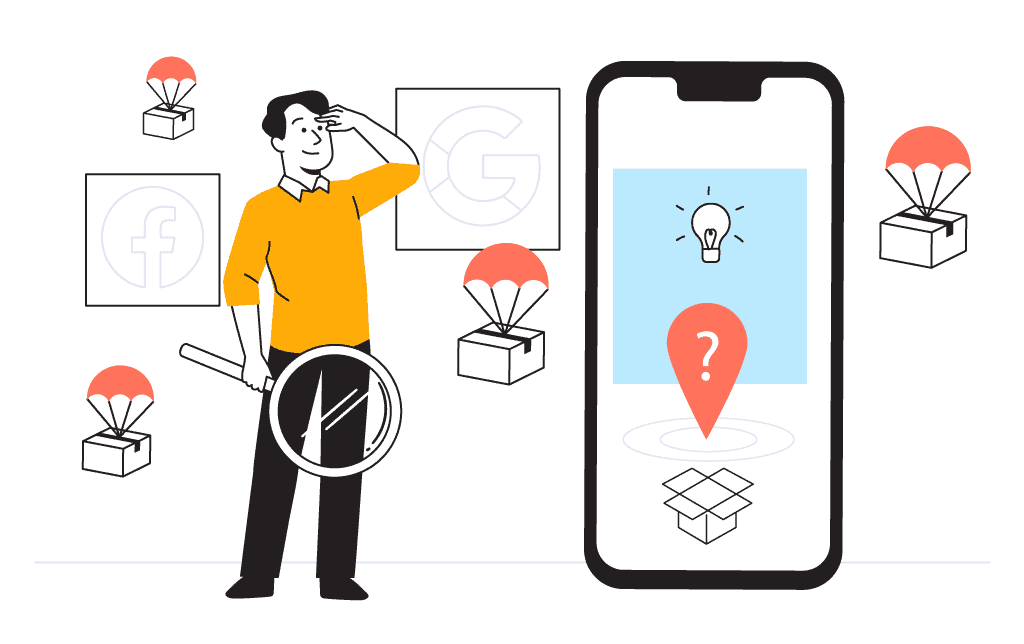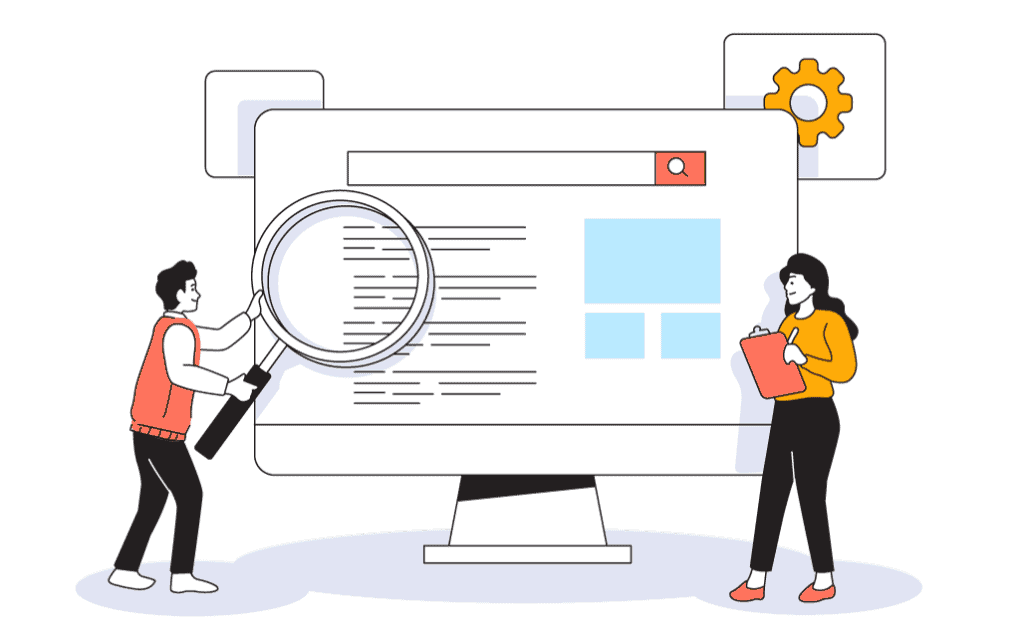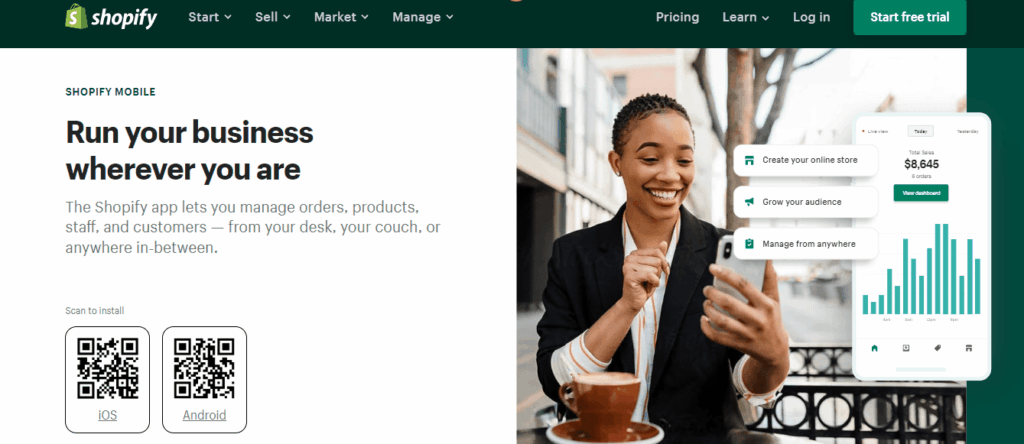[ad_1]
If you are reading this, you’ve probably done much research into Shopify already, which is great.
Shopify is the third-largest ecommerce platform behind eBay and Amazon, supporting 1.7 million businesses ranging from corporate giants to mom-and-pop shops.
But you may wonder where it all began.
For the curious, we’ve put together a little history lesson to explain the ecommerce platform’s early days, who runs it, and what transpired to drive it to expand into one of the most prominent ecommerce platforms today.
So, when did Shopify start?
How Shopify began

In 2004, friends Tobias Lütke, Scott Lake, and Daniel Weinand came up with a business idea to start selling snowboarding equipment online through a store known as Snowdevil.
Unfortunately, the ecommerce platforms that existed at the time didn’t cut it for them, and they took it upon themselves to create an ecommerce platform that suited their needs.
Lütke, a computer programmer, was at the forefront of this mission. But unfortunately, he encountered another problem along the way. Each tool he tried to use to build the ecommerce store frustrated him.
He wanted a simple and easy-to-use tool, but the existing off-the-shelf solutions like Yahoo! Stores didn’t offer it.
Lütke described it this way:
I set up our online store based on various systems such as Miva, OsCommerce, and Yahoo stores. Truth be told, all those systems made my skin crawl because of how bad they were. The final straw was when I got a custom design made for my snowboard store, and I couldn’t get it to work in Yahoo stores.
We had this great CSS-based layout done with all these new fanged ‘web standards,’ and the customizability of Yahoo Stores barely allowed me to change the background color of the top frame.
So, he decided to build everything, including the infrastructure for Snowdevil, from scratch. To do this, he used Rails, a programming framework developed by 37signals‘ David Heinemeier Hansson (now Basecamp).
They decided to use it because of the concept behind it. The program stressed that tools should be simple and enjoyable to use. This was exactly what Lütke expected when he attempted to use the time’s sophisticated and unwieldy ecommerce technologies.
After two months of development, the bare-bones Snowdevil was launched.
Then two years later, in 2006, the platform that hosted Snowdevil was renamed Shopify, eventually filling the void for the sort of platform its creators had wanted.

How the Shopify ecommerce store idea came about

After launching the store, Tobias Lütke, Scott Lake, and Daniel Weinand felt they were not optimizing their potential. Their calling was more inclined towards helping other businesses than running their own snowboard store.
That’s when they decided to shelve Snowdevil and focus on building a service that will help other merchants create their online stores seamlessly. That is how the gigantic ecommerce ecosystem we see today came to be.
Launching Shopify, the ecommerce ecosystem – 2006
In 2006, they officially launched Shopify as a set of tools merchants could use to build their own sites.
The initial tool assisted merchants in creating customizable shop templates, tracking orders through an RSS feed, and automating inventory organization.
They also incorporated simple but essential capabilities like picture uploading, tag addition, and item grouping.
Merchants could process payments by integrating PayPal or a credit card processor. Although these elements were simple but necessary for running an online store.
Thanks to Shopify, entrepreneurs who had never traded anything online had the basic tools they required to create a successful ecommerce business for the first time.

At first, growth was slow, but things changed in 2007 when the platform adjusted how it charged store owners. Initially, they used to charge transaction fees as a percentage of each sale. This turned off vendors who were making more money.
So, to help satisfy such merchants and create a win-win situation for everyone, they transitioned to a subscription-based plan and added a modest transaction fee that was reduced with plan size.
This is when the synergy between the business model and client success became apparent.
Shopify’s product development team now shifted their focus to creating tools that help clients sell more since every sale for a customer meant more income in transaction fees for Shopify.

This is how Shopify started seeing their customer’s success in their bottom line. Actually, by 2008, the company was doing $60,000 in monthly recurring revenue (MRR).
At the time, Shopify was primarily concerned with providing first-time merchants with the fundamental building blocks required to sell items online.
The most crucial fundamental features for first-time sellers were inventory management, order tracking, and basic analytics capabilities, which Shopify provided.
The transition from a tool to a platform – 2009
By the end of 2009, Shopify had cemented its place as an affordable, better, effective, and easy-to-use ecommerce tool that replaced old solutions like Microsoft Commerce and Yahoo! Stores.
Acknowledging the dynamic power of open-source software, the founders decided to build Shopify’s first external API and an app store.
Ecommerce is a highly individualized business. Every store wants a unique buying experience but providing too many features makes the software cumbersome and difficult to use.
The Shopify API solves this by allowing merchants to install exactly the features they need to get the most out of their store…and our Partners can get a recurring source of revenue by developing great applications for these stores.
Tobi Lutke, 2009
This move was pivotal to Shopify’s growth because it helped them expand when other web businesses were shrinking.
Many web businesses that failed to transition from tool to platform, as Shopify did, have never lived to see the light of the day today. Some, like Digg and Feedburner, were acquired and folded into larger companies.
The 2004-2008 software tool wave made the web friendlier by offering streamlined and simple tools. They replaced previous tools with enormous feature sets that had difficult user interfaces.

Shopify owners saw the opportunity and began the transition by releasing their API platform and app store in 2009. Developers could create and sell applications in the app store, while merchants could browse, buy, and install apps.
This enabled retailers to personalize and upgrade their online stores swiftly.
Shopify adds a mobile solution – 2010

In April 2010, Shopify joined the mobile revolution. They developed their first mobile app for Apple. And for the first time, Shopify store owners were able to manage their stores straight from their mobile devices.
Also, Shopify increased its ecommerce promotion efforts by establishing the “Build a Business” competition. This contest required business owners to open a store in eight months.
They set high stakes to encourage participation: the most successful startup would win $100,000 and receive coaching from celebrity entrepreneurs.
The challenge attracted over 1,000 new online shops, which made over $3 million in sales. Shopify was now serving over 11,300 stores and earning over $125 million in sales from those stores.
Launch of Shopify 2.0 – 2013

In 2013, Shopify launched Shopify 2.0. A powerful platform revamp with 60+ new features.
They analyzed customer feedback and implemented changes such as improved search functionality, easier-to-use admin features, a live theme editor, and refund management.
These makeover components were designed to make it easier for businesses to manage their Shopify stores. Shopify 2.0 also aided designers in swiftly prototyping and releasing new shops and applications.
The Shopify payments platform, one of the main reasons customers use Shopify, was also unveiled in August 2013. By 2014, the service had 120,000 merchants, and in 2015, the firm went public and began trading at $28 per share.

Shopify’s success story with POS

Next up on Shopify’s journey is its Point of Sale system. They unveiled Shopify POS in 2013, delivering in-store and online inventory synching, reporting for merchants selling in physical stores, and out-of-the-box credit card processing.
The new Shopify Payments tool was also included, allowing retailers to sync payments online and offline.
This feature eliminated the need for third-party payment channels, allowing retailers to avoid them.
They also created iPads with a point-of-sale system that immediately accepts debit and credit card payments. This iPad POS is still regularly utilized by physical business establishments.
Bridging the gap between online and offline storefronts 2014-Present
But POS was more than just another useful function. It was a pivotal moment for Shopify, allowing it to expand its reach further. Instead of growing on the internet, they intended to capture offline business this time.
They strived to “improve commerce for everyone.” This applied to anybody selling anywhere, not just those creating internet storefronts.
Here are some major initiatives they took:
- 2014: Shopify updated its app to support offline sales. Shopify Mobile now works with Shopify POS. Merchants could use the app as an additional register at retail establishments, add and alter stock listings, and automatically refresh changes to actual retail locations.

- 2014: Next up, they launched Shopify Plus, an ecommerce solution for businesses with huge inventory volumes. It provided limitless bandwidth and storage, customization, and priority account management.
- 2015: Shopify introduced Buy Buttons to sell items from any website, not only a Shopify store. The buttons allowed users to add Buy Buttons on their WordPress, Squarespace, and Tumblr websites.

- 2015: Still in 2015, they introduced Multichannel Shopify to the platform, which featured a dashboard for sellers to manage sales across several channels.
Because there were so many different methods to sell with Shopify—including the ecommerce storefront, POS, and buy buttons—merchants required a single area to handle their sales.

- 2017: Shopify closed the gap between online and offline shopping even further with Shopify QR codes. They allowed shoppers to scan a code on a physical item with their phone camera and directly access it in the merchant’s online store.

- 2019: Shopify and Snapchat launched an interface that allowed Shopify businesses to buy and manage Snapchat Story adverts straight from the Shopify platform. Previously, the platform had obtained similar integration deals with Facebook and Google.
- 2021: Shopify announced the purchase of Primer, an augmented reality (AR) app that allows customers to explore home renovation materials digitally.
Adapting to offline commerce has been a major driver of growth inside Shopify. It has also enabled merchants who previously exclusively sold online to sell in physical stores.
As a result, Shopify can better monetize its existing clients by charging higher transaction fees.
In the fiscal year 2021, Shopify made over 4.6 billion US dollars in total sales. Over the measured period, Shopify’s overall revenue increased substantially, growing by more than four billion since 2015.

Shopify’s history with dropshipping

Even though the concept of dropshipping had been around for decades, Shopify quickly became a dominant force in the rise of dropshipping.
Dropshipping on Shopify allowed entrepreneurs to keep costs low since products were only paid for and shipped after purchase.
With manufacturing, warehousing, and shipping outsourced to a third party, dropshipping gave entrepreneurs time to focus on marketing their products and building their brands.
Because of its ease of use and the variety of apps available to add inventory to your store, it’s understandable why Shopify is become and is still a popular platform choice for dropshipping.
For example, Meowingtons.com, a successful niche ecommerce site built on Shopify that specializes in all things cat, was launched in 2014. It was exclusively selling products available via dropshipping.

I suggest reading this article here to learn why Meowingtons is such a great example (it will also contain more great dropshipping store examples).
And then, in 2015, Oberlo was launched. Oberlo was a Shopify app that allowed retailers to turn their store into an AliExpress dropshipping store, automating the process.
It was so successful that in 2017, Shopify purchased Oberlo and integrated it even further. And then May 2022, Shopify announced that Oberlo would be shutting down.
Many Oberlo users were taken aback by this, leaving them rushing to find an alternate option. Fortunately, there are many Oberlo alternatives that can help you continue your business.
For online sellers using Shopify, Oberlo was a popular dropshipping plugin for years.
Users could easily import products to their stores and sell them directly from the inventory of thousands of suppliers. The app offered a huge range of products at low prices.

Today, thanks to Shopify, anyone can set up a dropshipping business. This is a considerable change from when only the most driven individuals with a solid understanding of ecommerce could be successful.
Related article: Interested in learning more about the history of dropshipping? Check out our other article here!
What’s behind Shopify’s sensational success?
What’s driving Shopify’s success, and what can we learn from them? Let’s find out:
Pinpointing user needs and developing an ecosystem around them
They focused on merchants’ primary path, goals, and pain areas to offer a hyper-relevant and extremely valued solution.
Shopify extended its solutions to target specific pain points such as the checkout, point of sale, and fulfillment experiences after developing tools enabling anyone to rapidly and inexpensively create an online store.
Empowering their customers and enabling them to focus on what matters
Instead of requiring each merchant to write code to get their business up and running, Shopify has built a robust framework that entrepreneurs can adopt, modify, and build upon.
Shopify offers business knowledge and assistance in addition to technical support. Reducing the technical threshold for small merchants to operate online stores is the most basic business of Shopify.
Shining the spotlight on their customers, not themselves
Shopify, unlike competitors, allows businesses to keep their independence. Shopify portrays itself as a blank canvas on purpose, allowing merchants to shine while Shopify stays in the background.
Taking advantage of the direct-to-consumer trend, Shopify is happy to stay out of the limelight while assisting its clients in shining.
Staying abreast of changing business and technology trends
They’ve stayed abreast of changing business and technology trends and built an ecosystem of targeted products that enable customers to achieve their goals.
Flexible pricing plans
Shopify offers a few pricing schemes with different features included in each plan and transaction fees charged. Shopify currently offers a 3-day trial + $1/month for the first 3 months. (More info here)
There are other plans with a monthly fee ranging from $39 to $399, plus a more customized Shopify Plus plan for larger merchants.

For more information about this, check out this article here!
Before we end, let’s answer one important question; who owns Shopify now?
Who owns Shopify now in 2023?
Shopify was founded by Tobi Lütke and headquartered in Ottawa, the capital of Canada. “Tobi” Lütke is a German-born Canadian billionaire entrepreneur.

While Tobias Lütke is still with Shopify as the CEO, the company has been publicly traded since April 2015, when it filed for an initial public offering on both the New York Stock Exchange and the Toronto Stock Exchange.
This means the company is owned by shareholders and managed by a board of directors.
Summary
Before we go to the final verdict, we’ve created a quick summary of this article for you, so you can easily remember it:
- Shopify was founded in 2006 by Tobias Lütke and Scott Lake.
- Shopify began as Snowdevil, an online store for snowboarding equipment.
- Tobias Lütke, and Scott Lake, ditched Snowdevil after they felt they were not optimizing their potential.
- The initial Shopify product only required basic tools to create a successful ecommerce store.
- At first, growth was slow, but things changed in 2007 when they switched to a subscription-based plan.
- Shopify transitioned from a tool to a platform in 2009. This move was pivotal to Shopify’s growth because it helped them expand when other web businesses were shrinking.
- In 2013, Shopify launched Shopify 2.0. A powerful platform revamp with 60+ new features.
- They unveiled Shopify POS in 2013, delivering in-store and online inventory synching,
- From 2014 to now, Shopify has been bridging the gap between online and offline storefronts through various products to cover both online and offline markets.
Conclusion
There you have it! From a snowboard shop to an $11 billion commerce ecosystem. We hope you enjoyed our brief history lesson and that you have some context to understand the ecommerce platform better.
We are dedicated to helping you achieve your goals. If you are new to ecommerce, check out our article How to Start an Online Store for Free: A Step-by-Step Guide.
There is no time like today to start an ecommerce store. And you can do it with adequate research and perseverance without spending tons of cash on online courses made by so-called ‘gurus.’
If you don’t find the answers to your questions on this blog, we’d love to hear from you.
Good luck!
Want to learn more about Shopify?
Ready to move your Shopify store to the next level? Check out the articles below:
Plus, don’t forget to check out our in-depth how to start a Shopify store guide here!
[ad_2]
Source link









